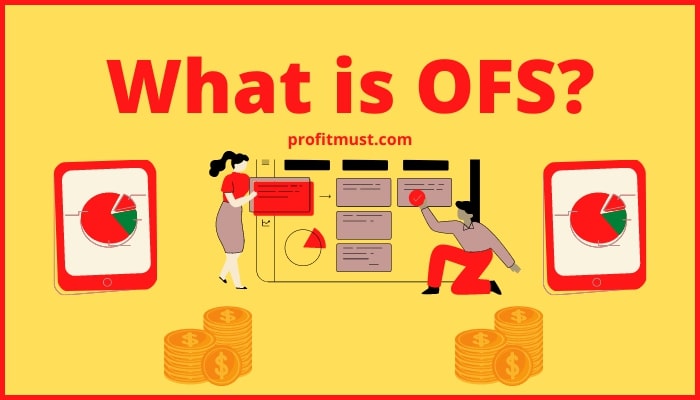A company’s aims may require more funding at times or they need to meet the regulations of SEBI regarding shareholding. These are when such firms can choose to offer an OFS. Do you know what is OFS? If not, let’s go through it in depth with examples and features.
Table of Contents
What is OFS?
OFS full form in stock market is offer for sale. It is an easier mechanism for public company promoters to sell their stocks and decrease their shareholding in a transparent way using the Exchange’s bidding system. SEBI initially announced the OFS Mechanism to the market in 2012.
Previously, the OFS category authorized only listed company Promoters/Promoters’ Group Entities to participate as “Sellers” to dilute/offload their ownership to attain a minimum public shareholding of 25%.
The category has now been expanded to include non-promoters of qualified companies that own at least 10% of the firm’s stock.
Allocation
- To make it simpler for publicly traded company promoters to reduce their holdings and meet the minimum public shareholding requirement.
- If the order/bid falls below the floor price, no allocation will be made.
- Mutual funds and insurance companies will get at least 25% of the equity shares, subject to allocation methodology.
- Except for mutual funds and insurance firms, no single buyer shall be given more than 25% of the amount of the offer for sale.

Also Read: How to apply for rights issue online?
Settlement
The settlement will be done on a trade-for-trade basis. Settlement will take place on T+1 day for non-institutional orders/bids and institutional orders with a 100 percent margin. If institutional investors place orders/bids with no margin, they will be settled according to secondary market regulations.
Other Important Points
- From 9.15 a.m. to 2.45 p.m., clients can place an OFS order.
- Orders in OFS can be changed at any time.
- The bid will not go ahead if the OFS order is denied by the exchange for any cause.
How to Bid for Offer For Sale?
In order to purchase stock in an OFS, a buyer must submit a bid. The firm establishes a ‘floor price.’ Buyers are not allowed to bid under the floor price. After the bids are submitted, the shares are assigned to the various buyers.
There is no minimum age requirement to take part in an OFS. In the OFS mechanism, a purchaser can bid for a single stock.
How to Invest?
You can submit your bid in the retail section of the OFS as an individual investor. Your maximum bid value in this section should not surpass Rs 2 lakh rupees. Otherwise, it will be disqualified.
To invest in an OFS, you’ll also need a demat account and a trading account. You can still put your bids via an appointed dealer if you’re an offline investor.
Ideal Company to Invest?
The OFS approach is used by companies to obtain additional capital and dilute promoters’ ownership. When compared to other methods of generating funds, this is a considerably easier approach. If the firm has a high reputation and future growth potential, it is excellent to participate in an OFS.
Advantages and disadvantages of OFS
After understanding what is ofs lets talk about advantages and disadvantages. These are major pros and cons of OFS:
-
Pros of OFS
- When buying shares through OFS, retail investors are usually given a discount off the floor price. In these deals, the discount is typically in the 5% area. One of the main advantages of investing through OFS for ordinary investors is the lower price.
- OFS is a bidding platform that is based on a system. As a result, the investor is only required to fill out little documentation. As a result, OFS is a straightforward and quick procedure.
- There are no extra costs when you use OFS to place your bids. Only the usual transaction and Securities Transaction Charges (STT) for equity investments apply. As a result, OFS is a cost-effective investment option.
-
Cons of OFS in share market
- Retail investors are required to get a minimum of 10% of the offer, according to SEBI norms. In the case of power supplies, this might be as high as 20%. This is, nevertheless, significantly less than the 35 percent reservation for individual investors in the case of initial public offerings (IPOs).
- An OFS has a maximum issue time of one trading day. An FPO, on the other hand, can be open for ranging from 3 to 10 days. Two banking days before the OFS, the issuing firm must notify the stock exchanges. That is why it is critical to stay current in order to prevent missing out on a lucrative investment tool.
Checklist for Offer for Sale
A fair offer for sale (OFS) enables promoters to minimise their interests in publicly traded companies. The promoters’ shares are available for purchase directly from the public through a bidding system.

Steps to apply in ofs in share market
An OFS can be participated in by any retail investor (individual investor). However, you will need a trading account as well as a demat account to do so. You can place an OFS bid immediately through your online trading portal or with the assistance of your dealer.
In contrast to IPOs, there is no documentation required to bid in an OFS. All you have to do is specify the quantity and pricing range for the OFS issue.
Process of OFS
You must bid at a price greater than the ‘floor price’ in order to obtain shares allotted in an OFS. The least price at which you can submit in the OFS is called a floor price. Any bid that is less than this amount will be rejected.
OFS shares are distributed in one of two ways:
- Single clearing price
- Multiple clearing price
When a single clearance price is used, all investors are given the same amount of stocks at the same price. However, in the event of multiple clearing prices, stocks are assigned to investors in order of price demand.
Example
X and Y, two investors, seek for an OFS. X puts in a bid of Rs 260 per share, while Y puts in a bid of Rs 267. When it comes to allocating shares, Y would be given priority over X in this case.
Fortunately, there is another alternative for investors: the cut-off price option. During an ofs in share market, a cut-off price is the cheapest rate at which an investor is given shares.
This allows the investor to apply for stocks at the cut-off price without having to bother regarding price discovery during the bidding process.
Retail category
The retail and non-retail categories (the Non-Institutional Investors (NII) category) are open to retail investors. According to SEBI requirements, corporations must provide individual investors with a minimum 10% reserve.
It’s worth noting that the total bid for regular investors should not exceed Rs 2 lakh. In other terms, a single investor can use a single account to make several bids in an ofs in share market.
The bids become disqualified if the total amount bid by the investor in several bids surpasses Rs 2 lakh.

Conclusion
An offer for sale is a simple, cost-effective, and time-efficient approach for a retail investor to purchase shares in a publicly traded firm. It is also a straightforward and convenient mechanism for promoters to dilute their stakes in a publicly traded firm.
This is all from our side reading What is OFS? Let us know your views about ofs in share market in the comment section if you have any doubts.
Other Interesting blogs related to What is OFS?
Difference Between Bulk Deal and Block Deal
Difference Between IPO and FPO
How to Apply for Buyback of Shares Online
FAQ About ofs meaning
What is OFS in IPO?
A offer for sale (OFS) allows promoters to minimise their stakes in publicly traded companies. The promoters' shares are available for purchase directly from the public through a bidding system.
OFS full form?
The Full Form of OFS is Offer for sale.
What is OFS issue
A offer for sale (OFS) issue allows promoters to minimise their stakes in publicly traded companies. The promoters' shares are available for purchase directly from the public through a bidding system.
When are OFS shares allotted?
At the conclusion of the day, i.e. after 6:00 p.m. on the day of the OFS, stock exchanges release allotment reports with trading members. On the same day, investors might get information from their trading participants.
OFS Zerodha?
You can apply in OFS via Zerodha with on issues. You can find the option in Corporate action orders.

